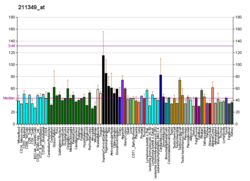
Sodium–hydrogen antiporter 3 also known as sodium–hydrogen exchanger 3 (NHE3) or solute carrier family 9 member 3 (SLC9A3) is a protein that in humans is encoded by the SLC9A3 gene.

Sodium bicarbonate cotransporter 3 is a protein which in humans is encoded by the SLC4A7 gene.

Electrogenic sodium bicarbonate cotransporter 1, sodium bicarbonate cotransporter is a membrane transport protein that in humans is encoded by the SLC4A4 gene.

Concentrative nucleoside transporter 2 (CNT2) is a protein that in humans is encoded by the SLC28A2 gene.

Urea transporter 1 is a protein that in humans is encoded by the SLC14A1 gene.

Concentrative nucleoside transporter 1 (CNT1) is a protein that in humans is encoded by the SLC28A1 gene.

Proton-coupled amino acid transporter 1 is a protein that in humans is encoded by the SLC36A1 gene.

Potassium-chloride transporter, member 4 is a chloride potassium symporter protein. It is encoded by the gene SLC12A4.

Solute carrier family 26 member 6 is a protein that in humans is encoded by the SLC26A6 gene. It is an anion-exchanger expressed in the apical membrane of the kidney proximal tubule, the apical membranes of the duct cells in the pancreas, and the villi of the duodenum.

Electroneutral sodium bicarbonate exchanger 1 is a protein that in humans is encoded by the SLC4A8 gene.

Solute carrier family 12 member 6 is a protein that in humans is encoded by the SLC12A6 gene.

Solute carrier family 15, member 2, also known as SLC15A2, is a human gene.

Organic solute transporter alpha, also known as OST-alpha, is a protein which in humans is encoded by the SLC51A gene.

Solute carrier family 13 member 2 is a protein that is encoded in humans by the SLC13A2 gene.

Organic solute transporter beta, also known as OST-beta, is a protein which in humans is encoded by the OSTB gene.

Solute carrier family 6, member 18 also known as SLC6A18 is a protein which in humans is encoded by the SLC6A18 gene.

Proton-coupled amino acid transporter 2 is a protein which in humans is encoded by the SLC36A2 gene.

Monocarboxylate transporter 10, also known as aromatic amino acid transporter 1 and T-type amino acid transporter 1 (TAT1) and solute carrier family 16 member 10 (SLC16A10), is a protein that in humans is encoded by the SLC16A10 gene. SLC16A10 is a member of the solute carrier family.

Solute carrier family 12 member 9 (SLC12A9), also known as cation-chloride cotransporter 6 (CCC6) or cation-chloride cotransporter-interacting protein 1 (CIP1), is a protein that in humans is encoded by the SLC12A9 gene.
Proteins of the Proton-dependent Oligopeptide Transporter (POT) Family are found in animals, plants, yeast, archaea and both Gram-negative and Gram-positive bacteria, and are part of the major facilitator superfamily. The transport of peptides into cells is a well-documented biological phenomenon which is accomplished by specific, energy-dependent transporters found in a number of organisms as diverse as bacteria and humans. The proton-dependent oligopeptide transporter (PTR) family of proteins is distinct from the ABC-type peptide transporters and was uncovered by sequence analyses of a number of recently discovered peptide transport proteins. These proteins that seem to be mainly involved in the intake of small peptides with the concomitant uptake of a proton.
















